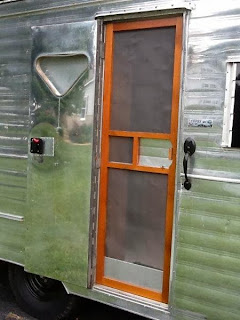First off, we decided that we were never going to use the stove/range. We did want a cook top but never had any plans to use the oven. So, why have that even in the camper? On top of that, it wasn't hooked up (due to the previous owner not wanting to go through the inspection process). So, I removed it last Fall. It's pretty heavy to boot.
Additionally, I was not happy with the air conditioning set-up and small dorm refrigerator that was at the opposite end of the galley. The A/C will be relocated to the other (curb) side of the trailer, in the closet, while a bar-type fridge will be used in place of the dorm-style fridge that came with the Tepee.
To make room for the bar-type fridge (which is a little wider and twice as tall), I needed to shift the galley frame work 2 inches to the rear (or left, in the pictures) of the trailer. As illustrated below, colored arrows 1, 2 & 3 (yellow & red) indicate where I cut out 2 inch sections of the frame. Now I had room for the new fridge, had a new storage location (where the stove used to be) and still had enough room to install a cook-top, in the counter top, without interference from the frame.
The stove back stop is sitting dead center in the image, as indicated with a purple triangle shaped symbol. That was discarded.
Kasey decided that, while she likes the golden color of the exposed wood interior, the galley needed to be brightened. So, the framing got a coat of pale green and the doors/drawers painted white. Also, all of the door/drawer pulls were replaced with new. They have a nickle finish with pale green glass, to match the the paint.
Air conditioner; after doing quite a bit or research, we decided not to relocate the existing A/C unit. It would require us to punch a hole, in the side of the trailer to exhaust the heat, as well as install a roof vent to provide air to cool the coils.
So, we opted to look into a portable air conditioner. These units use evaporative cooling to keep the condensate to a minimum and recirculate air throughout the trailer. They do exhaust hot air but that only requires one opening in the trailer skin; through the roof. I can handle a roof vent and I can handle a condensate drain. I don't much like a 10" x 17" opening in the side of my trailer (which would blow hot air on us as we sat under the awning).
If you read on-line reviews, you'll notice that the main complaint, two actually, is the noise of these units. Most folks can't deal with them in a bedroom (where they're most popular) because they're unable to sleep through the sound. Additionally, they don't like having to drain the condensate tank so often (hence the reason I'm going to pipe a drain). There are a few reviews that actually mention decibel levels. Most units are 50+ dBA which can be pretty noisy. We were hoping to find a unit in the upper 40s. On a lark, we stopped at one of our local appliance retailers. Naturally, they did not have floor units so we couldn't listen to them run. So, Kasey played "good customer" while I decided to be difficult (jerk customer). The manager eventually allowed us to buy the unit and then unpack it and plug it in, in to test it. If we weren't happy with the noise, we could immediately void the sale. We chose a quiet location near the back of the store. We were impressed by how quiet it was and subsequent on-line research listed it at 46 dBA. On top of that, it was quite a bit less expensive than the other two units we were considering. We chose this: Haier HPRB08XCM. We plan to test it's noise level, again, in our bedroom, before we install it in the trailer. That way, if it does turn out to be too loud for sleeping, it can go back. However, I think that GE window unit may find itself listed for sale soon.























a.jpg)

a.jpg)










